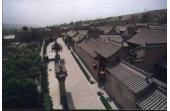Mianshan Mountain
- Things to do
-
- Photo(10)
- Tips&article(1)
- Make it Happen
- Map
-
loading...
Summary
Mian Shan (绵山 /Myen Shan/ ‘Silky’ Mountain) is noted for its natural scenery, especially for its cultural and religious relics. It is also the birthplace of Qingming Festival (Grave Cleaning Day), which is one of China’s most important traditional festivals and items of intangible cultural heritage.
Overview
With a history dating back some 2,500 years ago, Mian Shan boasts enchanting natural scenery and cultural significance. It is a national scenic spot with 14 tourist areas containing about 400 attractions. Besides, there are several restaurants and hotels that were built hanging on the steep cliffs, which provide a unique dining or accommodation experience for travelers.
The spectacular scenes and cultural relics at Mian Mountain provide tourists with many activities, such as watching sunset or sunrise at Dragon Head Temple, visiting Daluo Palace (the largest Taoist temple in China), walking on Sky Bridge and enjoying the natural beauty of Shuitao Valley.
Dragon Head Temple is the best place to watch sunrise or sunset in a sea of clouds. It is also a landmark of Mian Shan with its exquisite architecture. Daluo Palace is the largest Taoist temple in China. It was built and restored during the Tang Dynasty (618–907), and the supreme spirit of Taoism and other folk gods are worshipped there.
Daluo Palace also has the largest Taoist sutra depository over the country. Sky Bridge was built between steep cliffs, 300 meters (328 yards) long and no more than one meter (3.3 feet) wide. It is suspended over 300 meters (980 feet) from the bottom of a valley and over 200 meters (660 feet) from the mountain tops.
Mian Shan is also called Jie Shan (Jie Mountain) after Jie Zhitui (?–636 BC) a loyal defender of the Duke of Jin (697–628 BC). Jie Zhitui is reputed to have made soup with the flesh of his own leg for the duke when he was starving. After Jie had resigned his service to the duke, he lived on Mian Shan.
The duke later wanted to reward him, but could not find him, so he had the mountain burnt in an effort to drive Jie out. Jie and his mother were later found tragically burnt to death on the mountain. The Duke of Jin then instituted Hanshi (Cold Food) Day in 636 BC in remembrance of Jie, which later became the Qingming Festival.
Jiexiu, the city to the north of Mian Shan and the prefecture in which Mian Shan lies, means “the Resting Place of Jie”.
Location
Mian Shan is located in Jiexiu City of central Shanxi Province, central North China, midway between Beijing and Xi’an. It is 40 kilometers (25 miles) south of Pingyao, 137 kilometers (85 miles) south of Taiyuan, or 440 kilometers (274 miles) south of Datong.
Mian Shan car park is about 25 km (16 miles) by road south of Jiexiu Railway Station.
Nearby Attractions
- Zhangbi Ancient Village
- Pingyao Ancient Town
Recommended Tours
- Pingyao Classic Tour with Mian Shan (Mian Mountain) Combo
- Contact us for a tailor-made tour to Mian Shan (Mian Mountain)
Related Reading
- China's Festivals and Events
- China's World Heritage Sites
- Selected China Festival Tours
Tips & articles
|










